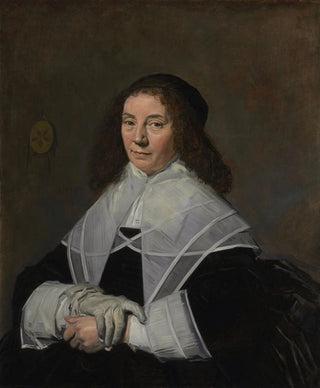Dorothée Berck 1593-1684 wife of Joseph Coymans 1591 after 1660 - Frans Hals | Art print


View from behind

Frame (optional)
In the world of 17th-century Dutch painting, few works manage to capture the essence of an era as rich as that of Frans Hals. His painting depicting Dorothée Berck, wife of Joseph Coymans, stands out for its striking realism and ability to evoke rare intimacy. This portrait, created around 1660, not only testifies to the undeniable talent of the artist but also reflects the values and aspirations of a rising bourgeois class. As you contemplate this piece, you are transported into a universe where beauty and dignity intertwine, revealing the complexity of human relationships through the lens of painting.
Style and uniqueness of the work
Frans Hals's style is often characterized by its lively and dynamic approach, and the piece dedicated to Dorothée Berck is no exception. With a delicate color palette and bold brushstrokes, Hals manages to infuse a true personality into his subject. Light plays a crucial role in this painting, illuminating the woman's face with a softness that seems almost tangible. The texture of the clothing, rendered with remarkable meticulousness, enhances the sense of movement, making this work a perfect example of Baroque style. Every detail, from the sparkling jewelry to the folds of fabric, is executed with such precision that an immediate connection with the depicted character is felt. This ability to capture emotions and nuances of character is what sets Hals apart from his contemporaries and makes this work a timeless masterpiece.
The artist and his influence
Frans Hals, born in Antwerp in 1582, left an indelible mark on art history. His career, spanning several decades, is marked by a stylistic evolution that reflects the social and cultural changes of his time. As a master of portraiture, Hals knew how to bring his subjects to life with such authenticity that he inspired many artists, both of his era and subsequent generations. His painting technique, which favors spontaneity and light, paved the way for artistic movements such as

Matte finish

View from behind

Frame (optional)
In the world of 17th-century Dutch painting, few works manage to capture the essence of an era as rich as that of Frans Hals. His painting depicting Dorothée Berck, wife of Joseph Coymans, stands out for its striking realism and ability to evoke rare intimacy. This portrait, created around 1660, not only testifies to the undeniable talent of the artist but also reflects the values and aspirations of a rising bourgeois class. As you contemplate this piece, you are transported into a universe where beauty and dignity intertwine, revealing the complexity of human relationships through the lens of painting.
Style and uniqueness of the work
Frans Hals's style is often characterized by its lively and dynamic approach, and the piece dedicated to Dorothée Berck is no exception. With a delicate color palette and bold brushstrokes, Hals manages to infuse a true personality into his subject. Light plays a crucial role in this painting, illuminating the woman's face with a softness that seems almost tangible. The texture of the clothing, rendered with remarkable meticulousness, enhances the sense of movement, making this work a perfect example of Baroque style. Every detail, from the sparkling jewelry to the folds of fabric, is executed with such precision that an immediate connection with the depicted character is felt. This ability to capture emotions and nuances of character is what sets Hals apart from his contemporaries and makes this work a timeless masterpiece.
The artist and his influence
Frans Hals, born in Antwerp in 1582, left an indelible mark on art history. His career, spanning several decades, is marked by a stylistic evolution that reflects the social and cultural changes of his time. As a master of portraiture, Hals knew how to bring his subjects to life with such authenticity that he inspired many artists, both of his era and subsequent generations. His painting technique, which favors spontaneity and light, paved the way for artistic movements such as
12,34 €






